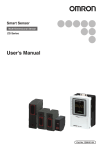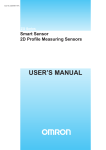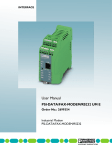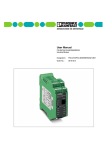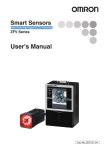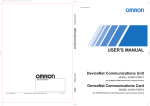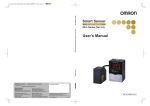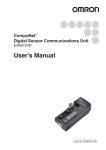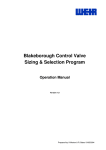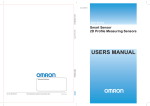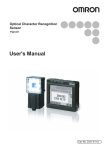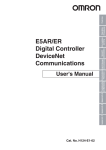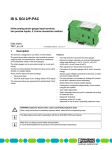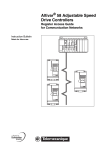Download ZS-CRT (CompoNet) Sensor Communications Unit User`s Manual
Transcript
ZS-CRT (CompoNet) Sensor Communications Unit for Smart Sensors USER'S MANUAL iv Introduction The ZS-CRT CompoNet Sensor Communications Unit was developed based on OMRON’s advanced control technologies and rich experiences. The ZS-CRT is designed to be used with ZS-series, ZG-series, and ZFV-C-series Smart Sensors. Intended Audience This manual is intended for the following personnel, who must also have knowledge of electrical systems (an electrical engineer or the equivalent) and computers. · Personnel in charge of introducing FA systems into production facilities · Personnel in charge of designing FA systems · Personnel in charge of installing and connecting FA systems · Personnel in charge of managing FA systems and facilities Notice This manual provides information on using a ZS-CRT Sensor Communications Unit. Be sure to read this manual before attempting to install or use the ZS-CRT, and keep the manual close at hand for reference during operation. Trademarks and Copyrights CompoNet is a registered trademark of the Open DeviceNet Vendors Association. Other product names and company names in this manual are trademarks or registered trademarks of their respective companies. The copyrights for the ZS-CRT Sensor Communications Unit belong to OMRON Corporation. © OMRON, 2007 All rights reserved. No part of this publication may be reproduced, stored in a retrieval system, or transmitted, in any form, or by any means, mechanical, electronic, photocopying, recording, or otherwise, without the prior written permission of OMRON. No patent liability is assumed with respect to the use of the information contained herein. Moreover, because OMRON is constantly striving to improve its high-quality products, the information contained in this manual is subject to change without notice. Every precaution has been taken in the preparation of this manual. Nevertheless, OMRON assumes no responsibility for errors or omissions. Neither is any liability assumed for damages resulting from the use of the information contained in this publication. v vi Read and Understand this Manual Please read and understand this manual before using the product. Please consult your OMRON representative if you have any questions or comments. Warranty and Limitations of Liability WARRANTY OMRON's exclusive warranty is that the products are free from defects in materials and workmanship for a period of one year (or other period if specified) from date of sale by OMRON. OMRON MAKES NO WARRANTY OR REPRESENTATION, EXPRESS OR IMPLIED, REGARDING NON-INFRINGEMENT, MERCHANTABILITY, OR FITNESS FOR PARTICULAR PURPOSE OF THE PRODUCTS. ANY BUYER OR USER ACKNOWLEDGES THAT THE BUYER OR USER ALONE HAS DETERMINED THAT THE PRODUCTS WILL SUITABLY MEET THE REQUIREMENTS OF THEIR INTENDED USE. OMRON DISCLAIMS ALL OTHER WARRANTIES, EXPRESS OR IMPLIED. LIMITATIONS OF LIABILITY OMRON SHALL NOT BE RESPONSIBLE FOR SPECIAL, INDIRECT, OR CONSEQUENTIAL DAMAGES, LOSS OF PROFITS OR COMMERCIAL LOSS IN ANY WAY CONNECTED WITH THE PRODUCTS, WHETHER SUCH CLAIM IS BASED ON CONTRACT, WARRANTY, NEGLIGENCE, OR STRICT LIABILITY. In no event shall the responsibility of OMRON for any act exceed the individual price of the product on which liability is asserted. IN NO EVENT SHALL OMRON BE RESPONSIBLE FOR WARRANTY, REPAIR, OR OTHER CLAIMS REGARDING THE PRODUCTS UNLESS OMRON'S ANALYSIS CONFIRMS THAT THE PRODUCTS WERE PROPERLY HANDLED, STORED, INSTALLED, AND MAINTAINED AND NOT SUBJECT TO CONTAMINATION, ABUSE, MISUSE, OR INAPPROPRIATE MODIFICATION OR REPAIR. vii Application Considerations SUITABILITY FOR USE OMRON shall not be responsible for conformity with any standards, codes, or regulations that apply to the combination of products in the customer's application or use of the products. At the customer's request, OMRON will provide applicable third party certification documents identifying ratings and limitations of use that apply to the products. This information by itself is not sufficient for a complete determination of the suitability of the products in combination with the end product, machine, system, or other application or use. The following are some examples of applications for which particular attention must be given. This is not intended to be an exhaustive list of all possible uses of the products, nor is it intended to imply that the uses listed may be suitable for the products: • Outdoor use, uses involving potential chemical contamination or electrical interference, or conditions or uses not described in this manual. • Nuclear energy control systems, combustion systems, railroad systems, aviation systems, medical equipment, amusement machines, vehicles, safety equipment, and installations subject to separate industry or government regulations. • Systems, machines, and equipment that could present a risk to life or property. Please know and observe all prohibitions of use applicable to the products. NEVER USE THE PRODUCTS FOR AN APPLICATION INVOLVING SERIOUS RISK TO LIFE OR PROPERTY WITHOUT ENSURING THAT THE SYSTEM AS A WHOLE HAS BEEN DESIGNED TO ADDRESS THE RISKS, AND THAT THE OMRON PRODUCTS ARE PROPERLY RATED AND INSTALLED FOR THE INTENDED USE WITHIN THE OVERALL EQUIPMENT OR SYSTEM. PROGRAMMABLE PRODUCTS OMRON shall not be responsible for the user's programming of a programmable product, or any consequence thereof. viii Disclaimers CHANGE IN SPECIFICATIONS Product specifications and accessories may be changed at any time based on improvements and other reasons. It is our practice to change model numbers when published ratings or features are changed, or when significant construction changes are made. However, some specifications of the products may be changed without any notice. When in doubt, special model numbers may be assigned to fix or establish key specifications for your application on your request. Please consult with your OMRON representative at any time to confirm actual specifications of purchased products. DIMENSIONS AND WEIGHTS Dimensions and weights are nominal and are not to be used for manufacturing purposes, even when tolerances are shown. PERFORMANCE DATA Performance data given in this manual is provided as a guide for the user in determining suitability and does not constitute a warranty. It may represent the result of OMRON's test conditions, and the users must correlate it to actual application requirements. Actual performance is subject to the OMRON Warranty and Limitations of Liability. ERRORS AND OMISSIONS The information in this manual has been carefully checked and is believed to be accurate; however, no responsibility is assumed for clerical, typographical, or proofreading errors, or omissions. ix Safety Precautions Safety-related Indications and Their Meanings The following precautionary indications and symbols are used in this manual to aid in the safe usage of the ZS-CRT Sensor Communications. These precautions contain important safety information. Be sure to observe them carefully. The indications and symbols used herein, and their meanings, are as listed below. Indicates a potentially hazardous situation which, if not avoided, WARNING could result in death or serious injury. Additionally, there may be severe property damage. Caution Indicates a potentially hazardous situation which, if not avoided, may result in minor or moderate injury, or property damage. Precautions for Safe Use Indicates actions that should be done, or avoided, for the safe use of this product. Precautions for Correct Use Indicates actions that should be done, or avoided, to prevent operating failure or malfunction of this product, or to prevent adverse effects on the performance or functions of this product. Note Notes within the text of this manual indicate safety-related points and information that are equivalent in importance to those included in the Precautions for Safe Use sections. WARNING Be sure to configure the circuits for safety protection such as emergency stop circuits, interlock circuits, and/or limit circuits to the external control circuits so that the whole system operates on the safe side even if an abnormality occurs due to product failure or by external factors. Not doing so will lead to a serious accident due to abnormal operation. x Precautions for Safe Use Please observe the following precautions for safe use of the product: 1. Installation Environment • Do not use the product in environments where it can be exposed to flammable or explosive gas. • Do not install the product close to high-voltage devices and/or power devices in order to secure the safety of operations and maintenance. • Do not install the product outdoor. 2. Power Supply and Wiring • Do not apply voltage exceeding rated voltage or do not use AC power supply. • If using dedicated flat cables of each CompoNet system 5 mm or more away from each other without bundling them to avoid operational unstability due to interference. • When performing operations described below, turn OFF the power supplies to the PLC’s main unit and slaves, communication devices, and sensors: - Assembling the device - Setting up a DIP switch or rotary switch - Connecting cables or wiring • Do not connect any network other than CompoNet. • Do not connect any model other than allowed • Be sure to use the communication cables and connectors specified for CompoNet. • Be sure to confirm locking of devices with the locking mechanism such as a communication cable. • When performing wiring or construction, be careful to avoid metallic particles from entering into the unit. • When wiring a communication cable, observe the following: - Keep the communication cable away from power lines and/or high voltage lines. - Do not bend or fold the communication cable. - Do not pull the communication cable excessively. - Do not put anything on the communication cables. - Be sure to keep the communication cables in ducts. • Check the wiring and switch settings carefully before energizing. • Keep communication distances and the number of connected devices within the range defined by the CompoNet specifications. 3. Others • Do not disassemble, repair, or modify the product. • When performing the following operations, confirm that there is no influence on the facilities: - Changing PLC operation modes - Forced setting/resetting of relay contacts - Changing set values on the user program, current values, or PLC operation modes • Dispose of this product as industrial waste. • Do not pressurize this product when disposing of it. xi Precautions for Correct Use Please observe the following precautions to prevent failure to operate, malfunctions, or undesirable effects on product performance. 1. Instruction site Do not install the products in locations subject to the following conditions: ・Direct sunlight or near to heaters appliance ・Ambient temperature outside the rating ・Significant temperature change (with condensation) ・Relative humidity outside the rating ・Presence of corrosive or flammable gasses ・Presence of dust or iron particles ・Direct vibrations or shock to the body ・Direct splay of organic solvent, water or oil, etc. ・Strong magnetic or electric field. 2. Maintenance and Inspection Never use paint thinner, benzine, acetone, or kerosene to clean the product. Wipe out small dirt or dust carefully using a soft cloth containing a small quantity of alcohol. xii Revision History A manual revision code appears as a suffix to the catalog number on the front cover of the manual. Cat. No. Z277-E1-01 Revision Code Revision code 01 Date January 2008 Revision content Original production xiii Section 1 Overview 1 Section 2 Installation and Connections 2 Section 3 CompoNet Communications Settings 3 Appendix xiv Appendix Table of Contents Introduction .................................................................................................................... v Intended Audience ...............................................................................................................v Notice ...............................................................................................................................v Trademarks and Copyrights ................................................................................................v Safety Precautions ......................................................................................................... x Safety-related Indications and Their Meanings ...................................................................x Precautions for Safe Use .............................................................................................. xi Precautions for Correct Use......................................................................................... xii Revision History ...........................................................................................................xiii Table of Contents......................................................................................................... xv Section 1 Overview ........................................................................................... 1-1 1-1 Features and System Configuration.................................................................1-2 1-1-1 1-1-2 1-1-3 Overview............................................................................................................ 1-2 Features............................................................................................................. 1-3 System Configuration ........................................................................................ 1-4 Section 2 Specifications and Installation ............................................................ 2-1 2-1 Specifications and Dimensions ........................................................................2-2 2-1-1 2-1-2 2-2 Specifications..................................................................................................... 2-2 Dimensions ........................................................................................................ 2-2 Installation ........................................................................................................2-3 2-2-1 2-2-2 2-2-3 Mounting to DIN Track....................................................................................... 2-3 Ferrite Core Accessories ................................................................................... 2-3 Connecting to the Sensor Controller ................................................................. 2-4 Section 3 CompoNet Communications............................................................... 3-1 3-1 CompoNet Communications Overview ............................................................3-2 3-1-1 Overview................................................................................................................. 3-2 3-1-2 Example of Using Explicit Message Communications ........................................... 3-4 3-2 Nomenclature ...................................................................................................3-5 3-2-1 Nomenclature and functions................................................................................... 3-5 3-3 CompoNet Wiring .............................................................................................3-7 3-4 Operating Procedure........................................................................................3-8 3-4-1 Sensor Communications Unit Operating Procedure .............................................. 3-8 3-5 Remote I/O Communications ...........................................................................3-9 3-5-1 Allocating I/O Data in the Master............................................................................ 3-9 3-5-2 Remote I/O Communications Using a ZFV-C-series Controller........................... 3-14 xv 3-5-3 Setting Monitor Data with the CompoNet Support Software ................................ 3-15 3-6 Explicit Message Communications................................................................ 3-16 3-6-1 Basic Format of Explicit Messages ...................................................................... 3-16 3-6-2 Explicit Messages and No-Protocol Commands .................................................. 3-17 3-6-3 GET PARAMETER............................................................................................... 3-18 3-6-4 SET PARAMETER ............................................................................................... 3-19 3-6-5 EXECUTE MEASUREMENT................................................................................ 3-20 3-6-6 GET MEASUREMENT VALUES.......................................................................... 3-21 3-6-7 GET VERSION ..................................................................................................... 3-24 3-6-8 INITIALIZE SETTINGS......................................................................................... 3-25 3-6-9 SAVE SETTINGS ................................................................................................. 3-26 3-6-10 SWITCH BANK................................................................................................... 3-27 3-6-11 GET BANK NUMBER......................................................................................... 3-28 3-6-12 GET PROFILE.................................................................................................... 3-29 3-6-13 GET FLOW DATA .............................................................................................. 3-31 3-6-14 List of Error Codes.............................................................................................. 3-34 Appendix ............................................................................................. Appendix-1 Appendix 1 CompoNet Device Profile .................................................... Appendix-2 Appendix 1-1 Device Profile................................................................................ Appendix-2 Appendix 1-2 Object Implementation.................................................................. Appendix-3 xvi Section 1 Overview 1 1-1 Features and System Configuration 1-1-1 Overview Overview 1-1 Features and System Configuration 1-1-1 Overview The Communications Unit is connected between a Smart Sensor and a PLC or other controller using CompoNet communications. It enables monitoring Sensor measurement values and judgment results, as well as reading and setting parameters, from the controller. (The following Sensor Controllers are compatible: ZS-LDC@@, ZS-MDC@@, ZS-HLDC@@, ZFV-CA@@, and ZG-WDC@@.) The Communications Unit and Sensor Controller are connected with USB. CompoNet’s remote I/O communications can be used to monitor measurement values and judgments without any programming. Explicit message communications can be used to read and set Sensor parameters and to execute measurements. 1-2 1-1 Features and System Configuration 1-1-2 Features 1 Communications Interface That Connects Smart Sensors with a Host, Including OMRON PLCs (such as the CS Series, CJ Series, and C200HX/HG/HE), As Well As CompoNet-compatible Computers or PLCs from Other Companies z Remote I/O Communications Slaves (ZS Series or ZG Series.) Remote I/O communications can be used to send Smart Sensors judgments and measurement values (maximum of 4 tasks) can be transmitted to the host PLC (master) without programming. z Message Communications Commands from the PLC can be used to send measurement triggers and set parameters, such as those for measurement modes and thresholds. Data such as flow data, threshold values, and other parameters can be read. 1-3 Overview 1-1-2 Features 1-1 Features and System Configuration 1-1-3 System Configuration 1 Overview 1-1-3 System Configuration CompoNet Support Software CS/CJ-series CompoNet Unit PLC Serial connection (ZS-CRT communications parameter setting CompoNet CompoNet Slave Sensor Controller ZS-CRT Sensor Communications Unit USB Cable (Sensor Communications Unit and Sensor Controller are connected with USB.) Note: The Sensor Communications Unit can be connected only to the Sensor Controller for channel 0. The Sensor Communications Unit will not operate if it is connected to a Sensor Controller for any other channel. 1-4 Section 2 Specifications and Installation 2-1 Specifications and Dimensions 2-1-1 Specifications 2-1 Specifications and Dimensions 2 Mounting and Connecting 2-1-1 Specifications Item Specifications Connected Sensor ZS Series ZG Series Communi- Remote I/O communi- • USB communications • USB communications cations cations status status • Judgments • Judgments • Measurement values • Measurement values Message communica- • Setting and reading Sen- • Setting and reading Sentions sor parameters sor parameters • Setting, monitoring, • Reading flow data • Sending measurement and controlling triggers and reading measSensors from the urement values Support software Power supply Supplied from the CompoNet communications connector. Sensor Controller connection Can be connected only to channel 0. channel Compatible Sensor Controllers • ZS-LDC@@ • ZG-WDC@@ (Ver. 2.300 or higher) (Ver. 1.100 or higher) • ZS-MDC@@ (Ver. 2.200 or higher) • ZS-HLDC@@ (Ver. 1.030 or higher) Power supply voltage 14 to 26.4 V DC Current consumption 200 mA max. Ambient operating temperature 0 to 50 °C Ambient operating humidity 25% to 85% Ambient storage temperature −15 to 60 °C (with no icing or condensation) Size (mm) 30 × 58.2 × 98 mm (W × H × D) Weight 130 g ZFV-C Series • USB communications status • Setting and reading Sensor parameters • Sending measurement triggers and reading measurement values • ZFV-CA@@ (Ver. 1.300 or higher) 2-1-2 Dimensions NS indicator USB indicator Function setting switch MS indicator Node address setting switch (×1) Two, M4 USB cable Mounting holes CompoNet communications connector Node address setting switch (×10) Round 3.8-dia. vinyl-insulated cab-tyre cable, Standard length: 750 mm Length with 2 ferrite cores attached: 450 mm (reference dimension) 2-2 2-2 2-2-1 2-2 Installation Mounting to DIN Track Installation 2 1. Insert the hook on the opposite side of the CompoNet connector onto the DIN Track. 2. Press the hook on the CompoNet connector side into the DIN Track. Do not mount by reversing the order of steps 1 and 2. Doing so could damage the mounting points. Press into the DIN Track. DIN Track 2-2-2 Ferrite Core Accessories Install the enclosed ferrite cores as shown in the following figure. Wrap the cable once around each ferrite core. 2-3 Mounting and Connecting 2-2-1 Mounting to DIN Track 2-2 Installation 2-2-3 Connecting to the Sensor Controller 2-2-3 Connecting to the Sensor Controller Connect the Unit to the USB connector on the Sensor Controller. 2 Mounting and Connecting 2-4 Section 3 CompoNet Communications 3-1 CompoNet Communications Overview 3-1-1 Overview 3-1 CompoNet Communications Overview 3-1-1 Overview 3 CompoNet Communications Remote I/O Communications (ZS Series and ZG Series) The ZS-CRT Communications Unit reads judgments and measurement values from the Smart Sensor and stores them in the Master Input Area. Monitored data Judgments Allocated words Input Area: 2 words Communications data Status • USB communications status between Sensor Communications Unit and Smart Sensor • Monitoring status for each task (monitored or not monitored) Judgments • Judgments for tasks 1 to 4 (HIGH, PASS, LOW, or ERROR) Measurement values Input Area: 2 words + Number of monitored tasks × 2 Status • USB communications status between Sensor Communications Unit and Smart Sensor • Monitoring status for each task • Decimal point format and number of decimal places for measurement values Measurement Values for Tasks 1 to 4 • Two words are used for the measurement value for one task. 3-2 3-1 CompoNet Communications Overview 3-1-1 Overview Judgments + Measurement values Input Area 2 words + Number of Status • USB communications status between Sensor Communications Unit and Smart Sensor • Monitoring status for each task (monitored or not monitored) • Decimal point format and number of decimal places for measurement values monitored tasks × 2 Judgments 3 M0easurement Values for Tasks 1 to 4 • Two words are used for the measurement value for one task. Explicit Message Communications The Sensor Communications Unit sends explicit message commands to read and write parameters in the connected Sensor Controller. Command Description Applicable GET PARAMETER Reads the set value of Sensor Controller parameters. SET PARAMETER Changes the set value of Sensor Controller parameters. Sensors ZS, ZG, ZFV-C ZS, ZG, ZFV-C EXECUTE MEASUREMENT Sends measurement triggers. ZG, ZFV-C GET MEASUREMENT VALUES Reads current measurement values. ZS, ZG, ZFV-C GET VERSION Reads the Sensor Controller version. ZS, ZG, ZFV-C INITIALIZE SETTINGS Returns all Sensor Controller data to the default settings. ZG, ZFV-C SAVE SETTINGS Saves all bank data to flash memory in the Sensor Controller. ZS, ZG, ZFV-C SWITCH BANK Switches the current bank. ZS, ZG, ZFV-C GET BANK NUMBER Reads the current bank number. ZS, ZG, ZFV-C GET PROFILE Reads the profile. ZG GET FLOW DATA Reads flow data. ZS 3-3 CompoNet Communications • Judgments for tasks 1 to 4 (HIGH, PASS, LOW, or ERROR) 3-1 CompoNet Communications Overview 3-1-2 Example of Using Explicit Message Communications 3-1-2 Example of Using Explicit Message Communications Example: Saving Setting Data from the Sensor Controller 3 CompoNet Communications • Command Format for SAVE SETTING DATA: The following explicit message is sent. Destination node Service code Class ID address 1000 hex 0054 hex 00A1 hex Execution condition A20200 Communications Port Enabled Flag S: D01000 D01001 D01002 D01003 D01004 2 1 0 0 0 Attribute ID Data --- --- 151100 or 152412 Online or Message communications possible 8 0 0 0 0 0 0 5 A 0 2 0 4 1 0 D: D02000 3-4 Instance ID 0000 hex CMND D01000 D02000 D00000 Sends 10 bytes of command data from D01000 to destination node with node address 05, and stores 10 bytes of response data in D02000 onwards at the local node. (D00000: Control data) Command code Slave node address: 00 Service code: 0052 hex Class ID: 00A1 hex Instance ID: 0000 hex (unit number) First response word C: D00000 D00001 D00002 D00003 0 0 0 0 0 0 0 0 0 0 0 2 A A 0 0 D00004 0 0 0 0 D00005 0 1 2 C Number of command data bytes: 10 Number of response data bytes: 10 Destination network address: 0 Destination Sensor Communications Unit node address: 00 hex Destination unit address: 20 hex Response: Required, Communications port No.: 0, Number of retries: 0 hex Response monitoring time: 30 s 3-2 Nomenclature 3-2-1 Nomenclature and functions 3-2 Nomenclature 3-2-1 Nomenclature and functions 3 CompoNet Communications Indicators Sensor Controller USB Cable CompoNet communications connector DIP switch Node address setting switches LED Indicators The meanings of the indicators are as given in the following table. Indicator MS Lit Lit Normal status Fatal error Flashing Not lit Lit Non-fatal error Unit operating normally. Unit hardware error. Watchdog timer has timed-out. Setting error. Flashing Online but not participating Lit Flashing Not lit Fatal communications error Non-fatal communications error Power turned OFF/Initializing Lit Sensor communications in progress Flashing Sensor communications in progress Status Module status Green − Network status Green Red − USB Meaning Color Red NS Status definition Name USB communications status Power turned OFF Online and participating Green Lit Red − Flashing Not lit Sensor communications error Sensor communications error/Sensor not connected Power turned OFF A non-supported Sensor Controller is connected. Power turned OFF. Communications are operating normally and node is participating in the network. Communications operating normally and preparations to participate in the network are in progress. Duplication address setting error. Communications timeout. Power turned OFF or initializing. USB communications operating normally and I/O communications in progress. USB communications operating normally and message communications are being executed. EEPROM checksum error or USB communications error. (See note.) USB communications error (see note) or USB cable not connected. Connect a Sensor Controller that is not supported. Note: The indicator stays lit or flashes from the time that the power is turned ON until initializing the Sensor Controller has been completed and communications are possible. 3-5 3-2 Nomenclature 3-2-1 Nomenclature and functions Indicator Status during Normal Operation MS NS USB 3 Normal when lit green. Normal (online with communications established) when lit green. Normal when lit green indicating I/O communications are in progress, or flashing green indicating message communications are in progress. Switches CompoNet Communications Node address setting Switches x10 x1 The rotary switches are used to set the CompoNet node address. The left rotary switch sets the ten's digit, and the right rotary switch sets the one's digit. Set the Unit’s CompoNet node address to between 00 and 63. The switch settings are read when the power is turned ON. DIP Switch for Setting Functions ON 1 2 3 4 Turn OFF all pins. CompoNet Communications Connector The CompoNet communications cable is connected. Either a Flat Connector Plug or Open Type Connector (DCN4-TB4) can be connected to the CompoNet communications connector. Sensor Controller Cable The Sensor Controller cable is used for communications with the Sensor Controller. Connect the Sensor Controller using the USB port on the Sensor Controller. 3-6 3-3 CompoNet Wiring 3-2-1 Nomenclature and functions 3-3 CompoNet Wiring Attach the connector to the CompoNet communications cable, and then connect the connector to the CompoNet connector on the Sensor Communications Unit. 3 Refer to the following manuals for information on CompoNet communications cables, connector models, and installation methods. • • CRT1 CompoNet Slave Units and Repeater Unit OPERATION MANUAL (Cat. No. W457) CS1W-CRM21/CJ1W-CRM21 CompoNet Master Units OPERATION MANUAL (Cat. No. W456) 3-7 CompoNet Communications CompoNet communications connector 3-4 Operating Procedure 3-4-1 Sensor Communications Unit Operating Procedure 3-4 Operating Procedure 3-4-1 Sensor Communications Unit Operating Procedure 3 CompoNet Communications Step Item 1 Mount Sensor Communications Unit to DIN Track. 2 Install the ferrite cores on the Sensor Controller cable. 3 Connect the Sensor Controller to the Sensor Communications Unit. 4 Connect a CompoNet communications cable to the CompoNet communications connector. 5 Set the rotary switches. Description Mount the Sensor Communications Unit to the DIN Track. Connect the Sensor Controller after mounting the Unit to the DIN Track. Install the ferrite cores on the Sensor Controller cable. Connect the USB connector on the Sensor Controller cable to the USB port on the Sensor Controller. Connect a CompoNet communications cable to the CompoNet communications connector. Set the CompoNet Node address to between 0 and 63. 6 Set the DIP switch. Confirm that all pins are set to OFF. 7 Start the Sensor Controller. Set Sensor Controller USB communications. Turn ON the power to the Sensor Controller. 8 9 8 9 When connecting a ZS-series Sensor Controller, set the Controller communications setting to non-procedural communications. (The Sensor Communications Unit and Sensor Controller cannot communicate unless non-procedural communications is set.) Turn ON the DC The Sensor Communications Unit is powered through the CompoNet power supply. connector. Check the indicators. MS Normal when lit green. NS Normal (online with communications established) when lit green. USB Sensor communications in progress when lit green. Start communicaRemote I/O commu- Enable the scan list in the Master, and set the tions. nications PLC to RUN mode. Explicit message Send explicit messages from the Master. communications Note: Use the connected Sensor Controller in RUN mode. Communications are not possible in modes other than RUN mode. Also, do not use the controls on the Sensor Controller for operation when the Sensor Controller is connected to the Sensor Communications Unit. 3-8 3-5 Remote I/O Communications 3-5-1 Allocating I/O Data in the Master Unit 3-5 Remote I/O Communications 3-5-1 Allocating I/O Data in the Master Unit Monitored data Judgments Allocated words Input Area: 2 words Communications data Status • USB communications status between Sensor Communications Unit and Smart Sensor • Monitoring status for each task (monitored or not monitored) Judgments • Judgments for tasks 1 to 4 (HIGH, PASS, LOW, or ERROR) Measurement values Input Area: 2 words + Number of monitored tasks × 2 Status • USB communications status between Sensor Communications Unit and Smart Sensor • Monitoring status for each task • Decimal point format and number of decimal places for measurement values Measurement Values for Tasks 1 to 4 • Two words are used for the measurement value for one task. Judgments + Measurement values Input Area 2 words + Number of monitored tasks × 2 Status • USB communications status between Sensor Communications Unit and Smart Sensor • Monitoring status for each task (monitored or not monitored) • Decimal point format and number of decimal places for measurement values Judgments • Judgments for tasks 1 to 4 (HIGH, PASS, LOW, or ERROR) Measurement Values for Tasks 1 to 4 • Two words are used for the measurement value for one task. Note 1: When using measurement triggers with a ZG-series Sensor Controller, check the status of the GATE signal and refer to the measurement result after the measurement is triggered. An error value (−999.999) will be returned during trigger measurement. Note 2: When using measurement triggers with a ZG-series Sensor Controller, set the output response time to 30 s max. If the output response time is longer than 30 s, a communications error will be generated between the Sensor Communications Unit and the Sensor Controller. (Output response time = Measurement cycles x Average number of measurements) Note 3: When switching banks on the Sensor Controller, make sure that the switching operation is made through the Sensor Communications Unit. If banks are switched by using a bank input line, a communications error will be generated in the Sensor Communications Unit. 3-9 3 CompoNet Communications When using a ZS-series or ZG-series Sensor Controller, the Sensor Communications Unit can monitor Sensor judgments and measurement values by using CompoNet remote I/O communications. When using a ZFV-C-series Sensor Controller, only the USB communications status can be monitored by using remote I/O communications. Words in the Input Area in the CompoNet Master are allocated to the monitor data sent from the Sensor Communications Unit. The following three types of monitor data can be selected with the Sensor Communications Unit settings. (The data and tasks to be monitored are selected from the CompoNet Support Software.) 3-5 Remote I/O Communications 3-5-1 Allocating I/O Data in the Master Unit Monitored Data: Judgments Two words are allocated. Word m: Status 3 CompoNet Communications Bit 00 Description USB communications status 01 USB communications error Bit 08 09 to 11 Description Decimal format Number of decimal places 02 Judgment status 03 Measurement value status 04 Task 1 status Task 2 status 12 05 13 Reserved Reserved 06 Task 3 status 14 Reserved 07 Task 4 status 15 Reserved Word m + 1: Judgments Bit 00 Description Task 1, low Bit 08 Description Task 3, low 01 Task 1, pass 09 Task 3, pass 02 Task 1, high 10 Task 3, high 03 Task 1, error 11 Task 3, error 04 Task 2, low 12 Task 4, low 05 Task 2, pass 13 Task 4, pass 06 Task 2, high 14 Task 4, high 07 Task 2, error 15 Task 4, error Status • USB Communications Status: Turns ON when communications with the Sensor Controller have been established and correct I/O data is sent. • USB Communications Error: Turns ON when communications with the Sensor Controller are not normal. • Judgment Status: Turns ON when the judgment for either of tasks 1 to 4 is being monitored. • Measurement Value Status: OFF. • Task 1 to 4 Status: Turns ON when monitoring the judgment of the corresponding tasks. • Decimal Format: Indicates the measurement value decimal format (1: Fixed decimal point, 0: Floating decimal point). • Number of Decimal Places The number of decimal digits (1 to 5) when using the fixed decimal point format. Bit 9 is the rightmost digit, and bit 11 is the leftmost digit. For example, if there are 3 decimal digits, bit 9 and bit 10 will be set to 1, and bit 11 will be set to 0. Judgments Judgment for each task. The bit corresponding to each task is turned ON or OFF according to its judgment. 3-10 3-5 Remote I/O Communications 3-5-1 Allocating I/O Data in the Master Unit Monitored Data: Measurement Values Four to ten words are allocated. (The number of allocated words depends on the number of tasks for which the measurement value is being monitored.) Word m: Status Description USB communications status 01 USB communications error Bit 08 09 to 11 Description Decimal format CompoNet Communications Bit 00 Number of decimal places 02 Judgment status 03 Measurement value status 04 Task 1 status 12 Reserved 05 Task 2 status 13 Reserved 06 Task 3 status 14 Reserved 07 Task 4 status 15 Reserved Word m + 1: Not used. Words m + 2 to m + 9 (max.): Measurement Values 15 14 13 12 m+2 m+3 : : m+8 m+9 11 10 09 08 07 06 05 04 Task 1 measurement value, rightmost bytes Task 1 measurement value, leftmost bytes : : Task 4 measurement value, rightmost bytes Task 4 measurement value, leftmost bytes 03 3 02 01 00 Status • USB Communications Status: Turns ON when communications with the Sensor Controller have been established and correct I/O data is sent. • USB Communications Error: Turns ON when communications with the Sensor Controller are not normal. • Judgment Status: OFF. • Measurement Value Status: Turns ON when the measurement value for either of tasks 1 to 4 is being monitored. • Task 1 to 4 Status: Turns ON when monitoring the measurement value of the corresponding task. • Decimal Format: Indicates the measurement value decimal format (1: Fixed decimal point, 0: Floating decimal point). 3-11 3-5 Remote I/O Communications 3-5-1 Allocating I/O Data in the Master Unit • Number of Decimal Places The number of decimal digits (1 to 5) when using the fixed decimal point format. Bit 9 is the rightmost digit, and bit 11 is the leftmost digit. For example, if there are 3 decimal digits, bit 9 and bit 10 will be set to 1, and bit 11 will be set to 0. Measurement Values 3 CompoNet Communications The measurement value for each task. The tasks for which measurement values are to be monitored are set from the CompoNet Support Software. To monitor the measurement values of only specified tasks, the measurement values of only the specified task are returned starting from the beginning words. Example: Monitoring Only Task 2 15 14 13 12 11 m+2 m+3 10 09 08 07 06 05 04 Task 2 measurement value, rightmost bytes Task 2 measurement value, leftmost bytes 03 02 01 00 Monitored Data: Judgments + Measurement Values Four to ten words are allocated. (The number of allocated words depends on the number of tasks for which the measurement value is being monitored.) Word m: Status Bit 00 Description USB communications status 01 USB communications error Bit 08 09 to 11 02 Judgment status 03 Measurement value status Description Decimal format Number of decimal places 04 Task 1 status 12 Reserved 05 Task 2 status 13 Reserved 06 Task 3 status 14 Reserved 07 Task 4 status 15 Reserved Word m + 1: Judgment Bit 00 Description Task 1, low Bit 08 Description Task 3, low 01 Task 1, pass 09 Task 3, pass 02 Task 1, high 10 Task 3, high 03 Task 1, error 11 Task 3, error 04 Task 2, low 12 Task 4, low 05 Task 2, pass 13 Task 4, pass 06 Task 2, high 14 Task 4, high 07 Task 2, error 15 Task 4, error Word m + 2 to m + 9 (max.): Measurement Values 15 m+2 m+3 : : m+8 m+9 3-12 14 13 12 11 10 09 08 07 06 05 04 Task 1 measurement value, rightmost bytes Task 1 measurement value, leftmost bytes : : Task 4 measurement value, rightmost bytes Task 4 measurement value, leftmost bytes 03 02 01 00 3-5 Remote I/O Communications 3-5-1 Allocating I/O Data in the Master Unit Status • USB Communications Status: Turns ON when communications with the Sensor Controller have been established and correct I/O data is sent. • USB Communications Error: Turns ON when communications with the Sensor Controller are not normal. 3 • Measurement Value Status: Turns ON when the measurement value for either of tasks 1 to 4 is being monitored. • Task 1 to 4 Status: Turns ON when monitoring the measurement value or the judgment of the corresponding task. • Decimal Format: Measurement value decimal format (1: Fixed decimal point, 0: Floating decimal point). • Number of Decimal Places The number of decimal digits (1 to 5) when using the fixed decimal point format. Bit 9 is the rightmost digit, and bit 11 is the leftmost digit. For example, if there are 3 decimal digits, bit 9 and bit 10 will be set to 1, and bit 11 will be set to 0. Judgments The judgment for each task. The bit corresponding to each task is turned ON or OFF according to its judgment. Measurement Values The measurement value for each task. The tasks for which measurement values are to be monitored are set from the CompoNet Support Software. To monitor the measurement values of only specified tasks, the measurement values of only the specified task are returned starting from the beginning words. Example: Monitoring Only Tasks 2 and 4 15 m+2 m+3 m+4 m+5 14 13 12 11 10 09 08 07 06 05 04 Task 2 measurement value, rightmost bytes Task 2 measurement value, leftmost bytes Task 4 measurement value, rightmost bytes Task 4 measurement value, leftmost bytes 03 02 01 00 3-13 CompoNet Communications • Judgment Status: Turns ON when the judgment for either of tasks 1 to 4 is being monitored. 3-5 Remote I/O Communications 3-5-2 Remote I/O Communications Using a ZFV-C-series Controller 3-5-2 Remote I/O Communications Using a ZFV-C-series Controller When using a ZFV-C-series Controller, only the USB communications status will be sent when using CompoNet remote I/O communications. Word m: Status 3 CompoNet Communications Bit 00 Description USB communications status Bit 08 01 USB communications error 09 − − − − 10 − 03 11 − 04 − 12 05 − 13 − − 06 − − 14 − 15 − 02 07 3-14 Description 3-5 Remote I/O Communications 3-5-3 Setting Monitor Data with the CompoNet Support Software 3-5-3 Setting Monitor Data with the CompoNet Support Software • The data and tasks to be monitored are set from the CompoNet Support Software. Refer to the CRT1-series CompoNet Slave Units and Repeater Unit Operation Manual (Cat. No. W457) for information on general operating procedures for the CompoNet Support Software. 3 CompoNet Communications In the CompoNet Support Software, select the Sensor Communications Unit icon to display the setup dialog box shown above. The data and tasks to be monitored are set in this dialog box. Setting Sensor model Monitor mode Decimal format (Only for the ZG) Monitored data Task 1 to Task 4 Description The model of the connected Sensor will be displayed. This item cannot be selected only for the monitor. • Constant monitoring (with I/O monitor) Select when not using data logging. • Data logging (without I/O monitor) Select when using data logging with the Sensor Communications Unit. When data logging is selected, I/O monitoring will not be performed. • Floating decimal point Select to display floating decimal point. • Fixed decimal point Select to display a fixed decimal point. • Measurement values Select to monitor the measurement value. • Judgment Select to monitor the judgment. • Measurement + judgment Select to monitor the measurement value and judgment. • Monitor Select to monitor the corresponding task. • Do not monitor Select to not monitor the corresponding task. The items in bold font are the default settings. After setting the items to be monitored, download the necessary parameters to the Sensor Communications Unit. 3-15 3-6 Explicit Message Communications 3-6-1 Basic Format of Explicit Messages 3-6 Explicit Message Communications Explicit messages can be sent from the Master to the Sensor Communications Unit to read or write any parameters. The Sensor Communications Unit processes the command sent from the Master and then return a response. 3 CompoNet Communications 3-6-1 Basic Format of Explicit Messages The basic format of commands and responses is shown below. Command Format Destination Service node address code Class ID Instance ID Data Destination Node Address The node address of the Unit that is sending the explicit message (command) is specified as a 2-byte hexadecimal number. Note: When using an OMRON CompoNet Master Unit, the leftmost byte of the destination node address of the Sensor Communications Unit is 10 hex. For example, when sending to node address 02, the destination node address is 1002 hex. Service Code, Class ID, Instance ID, Data These parameters are used to specify the command, object to process, and processing content. Note: The number of bytes designated for the class ID, instance ID, and attribute ID depend on the Master Unit. When sent from an OMRON CompoNet Master Unit, the class ID and instance ID are 2 bytes (4 digits). Response Format · Normal Response Number of Source node bytes received address Service code Data Service code Error code · Error Response Number of bytes received Source node address 0004 hex (fixed) Number of Bytes Received The number of bytes received from the source node address is returned in hexadecimal. When an error response is returned for an explicit message, the number of bytes is always 0004 hex. Source Node Address The node address of the node from which the command was sent is returned in hexadecimal. Note: When using an OMRON CompoNet Master Unit, the leftmost byte of the destination node address returned by the Sensor Communications Unit is 10 hex. 3-16 3-6 Explicit Message Communications 3-6-2 Explicit Messages and No-Protocol Commands Service Codes For normal completion, the leftmost bit of the service code specified in the command is turned ON and the result is stored in the response as shown in the following table. Response service code 00CC hex 00CD hex 00D0 hex 00D1 hex 00D2 hex 00D3 hex 00D4 hex 00D5 hex 00D6 hex 00D7 hex 00D8 hex 3 When an error response is returned for an explicit message, the service code is always 0094 hex. Data Read data is included only when a read command is executed. Error Code The explicit message error code. For details, refer to the 3-6-14 List of Error Codes on page 3-34. 3-6-2 Explicit Messages and No-Protocol Commands The Sensor Communications Unit converts received explicit messages into no-protocol commands and sends them to the Sensor Controller. For details regarding no-protocol commands, refer to the no-protocol communications command reference or user’s manual. 3-17 CompoNet Communications Command service code 004C hex 004D hex 0050 hex 0051 hex 0052 hex 0053 hex 0054 hex 0055 hex 0056 hex 0057 hex 0058 hex 3-6 Explicit Message Communications 3-6-3 GET PARAMETER 3-6-3 GET PARAMETER The Get Parameter command reads Sensor Controller parameters. 3 CompoNet Communications Applicable Sensors No-protocol command ZS, ZG, ZFV-C “DATAGET” Command Format Destination node address Service code 10xx hex 004C hex (fixed) 2 bytes 2 bytes Class ID Instance ID Data 00A1 hex (fixed) 0000 hex (fixed) 2 bytes 2 bytes 2 bytes Data Unit number Parameter number 2 bytes 2 bytes Note: When using a ZS-series Sensor Controller, the data number will be set instead of the parameter number. Response Format · Normal Response Number of bytes received Source node address Service code Data 00CC hex (fixed) C400 + Data 2 bytes 2 bytes 6 bytes Source node address Service code 000A hex (fixed) 2 bytes · Error Response Number of bytes received 0006 2 bytes 3-18 Error code 0094 hex (fixed) 2 bytes 2 bytes 2 bytes 3-6 Explicit Message Communications 3-6-4 SET PARAMETER 3-6-4 SET PARAMETER The Set Parameter command changes the set values of Sensor Controller parameters. Applicable Sensors No-protocol command ZS, ZG, ZFV-C “DATASET” 3 CompoNet Communications Command Format Destination node address Service code Class ID Instance ID 10xx hex 004D hex (fixed) 00A1 hex (fixed) 0000 hex (fixed) 2 bytes 2 bytes 2 bytes 2 bytes Data 8 bytes Data Unit number Parameter C400 hex number (fixed) 1 byte 2 bytes 1 byte Set value 4 bytes Note: When using a ZS-series Sensor Controller the data number will be set instead of the parameter number. Response Format · Normal Response Number of bytes received Source node address 0004 2 bytes Service code 00CD hex (fixed) 2 bytes 2 bytes Source node address Service code · Error Response Number of bytes received 0006 2 bytes Error code 0094 hex (fixed) 2 bytes 2 bytes 2 bytes 3-19 3-6 Explicit Message Communications 3-6-5 EXECUTE MEASUREMENT 3-6-5 EXECUTE MEASUREMENT Sends a measurement trigger. 3 CompoNet Communications Applicable Sensors No-protocol command ZG “TRIG” ZFV-C “MEASURE” Command Format Destination node address Service code Class ID Instance ID 10xx hex 0050 hex (fixed) 00A1 hex (fixed) 0000 hex (fixed) 2 bytes 2 bytes 2 bytes 2 bytes Response Format · Normal Response Number of bytes received Source node address 0004 2 bytes Service code 00D0 hex (fixed) 2 bytes 2 bytes Source node address Service code · Error Response Number of bytes received 0006 2 bytes 3-20 Error code 0094 hex (fixed) 2 bytes 2 bytes 2 bytes 3-6 Explicit Message Communications 3-6-6 GET MEASUREMENT VALUES 3-6-6 GET MEASUREMENT VALUES Reads the current measurement values. Applicable Sensors No-protocol command ZS, ZG “MEASURE” ZFV-C “DATAGET” 3 Destination node address Service code Class ID 10xx hex 0051 hex (fixed) 00A1 hex (fixed) 2 bytes 2 bytes 2 bytes • Instance ID Data 0000 hex (fixed) Task number 2 bytes 1 byte Task number: Task number for which to read the measurement value (When the task number is set to 0, measurement values will be read for all tasks. This is applicable only for ZG-series Sensor Controllers.) Response Format The response format depends on the type of Sensor being used. ZS or ZFV-C · Normal Response Number of Source node Service code bytes received address 00D1 hex (fixed) 000Chex 2 bytes Data 2 bytes 2 bytes 8 bytes Data C400 hex 0400 hex Measurement (fixed) (fixed) value 2 bytes 2 bytes 4 bytes · Error Response Number of bytes received Source node address 0006 2 bytes Service code Error code 0094 hex (fixed) 2 bytes 2 bytes 2 bytes 3-21 CompoNet Communications Command Format 3-6 Explicit Message Communications 3-6-6 GET MEASUREMENT VALUES ZG · Normal Response for a Fixed Decimal Point Task Number Not 0 Number of bytes received 3 Source node address Data CompoNet Communications 00D1 hex (fixed) 000Chex 2 bytes Service code 2 bytes 2 bytes 8 bytes Data C4 hex Number of (fixed) integral digits 1 byte 1 byte Data length Measurement value 2 bytes 4 bytes Task Number Is 0 Number of bytes received Source node address 0018 hex 2 bytes Service code Data 00D1 hex (fixed) 2 bytes 2 bytes 20 bytes Data C4 hex Number of (fixed) integral dig- Data length Measurement value x 4 2 bytes 16 bytes its 1 byte 1 byte · Normal Response for a Floating Decimal Point Task Number Not 0 Number of bytes received Source node address 000Chex 2 bytes Service code Data 00D1 hex (fixed) 2 bytes 2 bytes 8 bytes Data CB00 hex Data length Measurement value 2 bytes 4 bytes (fixed) 2 bytes 3-22 3-6 Explicit Message Communications 3-6-6 GET MEASUREMENT VALUES Task Number Is 0 Number of bytes received Source node address 0018hex Service code Data 00D1 hex (fixed) 3 2 bytes 2 bytes 20 bytes CompoNet Communications 2 bytes Data CB00 hex (fixed) Data length Measurement value x 4 2 bytes 2 bytes 16 bytes · Error Response Number of bytes received Source node address 0006 2 bytes Service code Error code 0094 hex (fixed) 2 bytes 2 bytes 2 bytes Measurement values are read from the Sensor Controller as ASCII data. The Sensor Communications Unit converts the ASCII data to floating-point or fixed-decimal data. Examples: Fixed Decimal Point Conditions Number of integral digits: 3 Size: 16 If the value returned from the Sensor Controller is –999.999, the measurement value in the response will be 0xFFF0BDC1 (–999999). Floating Decimal Point The floating decimal point will be converted according to the IEEE754 standard. Condition Size: 32 If the value returned from the Sensor Controller is –999.999, the measurement value in the response will be 0xc08F3FFDF3B645A2. 3-23 3-6 Explicit Message Communications 3-6-7 GET VERSION 3-6-7 GET VERSION Reads the Sensor Controller version. 3 Applicable Sensors No-protocol command ZS, ZG, ZFV-C “VERGET” CompoNet Communications Command Format Destination node address Service code Class ID Instance ID 10xx hex 0052 hex (fixed) 00A1 hex (fixed) 0000 hex (fixed) 2 bytes 2 bytes 2 bytes 2 bytes Response Format · Normal Response Number of bytes received Source node address Service code Variable length 2 bytes Data 00D2 hex (fixed) 2 bytes 2 bytes Variable length Data Size Model + Version information 1 byte Variable length · Error Response Number of bytes received Source node address 0006 2 bytes 3-24 Service code Error code 0094 hex (fixed) 2 bytes 2 bytes 2 bytes 3-6 Explicit Message Communications 3-6-8 INITIALIZE SETTINGS 3-6-8 INITIALIZE SETTINGS Returns all Sensor Controller data to the default settings. Applicable Sensors No-protocol command ZG, ZFV-C “DATAINIT” 3 CompoNet Communications Command Format Destination node address Service code Class ID Instance ID ‘10xx hex 0053 hex (fixed) 00A1 hex (fixed) 0000 hex (fixed) 2 bytes 2 bytes 2 bytes 2 bytes Response Format · Normal Response Number of bytes received Source node address 0004 2 bytes Service code 00D3 hex (fixed) 2 bytes 2 bytes Source node address Service code · Error Response Number of bytes received 0006 2 bytes Error code 0094 hex (fixed) 2 bytes 2 bytes 2 bytes Note: When initializing the settings data with a ZS-series Sensor Controller, the communications settings for the Sensor Controller will return to CompoWay/F settings, and USB communications with the Sensor Communications Unit will result in an error. Reset the communications settings for the Sensor Controller to no-protocol communications 3-25 3-6 Explicit Message Communications 3-6-9 SAVE SETTINGS 3-6-9 SAVE SETTINGS Saves all bank data to flash memory in the Sensor Controller. 3 CompoNet Communications Applicable Sensors No-protocol command ZS, ZG, ZFV-C “DATASAVE” Command Format Destination node address Service code Class ID Instance ID 10xx hex 0054 hex (fixed) 00A1 hex (fixed) 0000 hex (fixed) 2 bytes 2 bytes 2 bytes 2 bytes Response Format · Normal Response Number of bytes received Source node address 00D4 hex (fixed) 0004 2 bytes Service code 2 bytes 2 bytes Source node address Service code · Error Response Number of bytes received 0006 2 bytes 3-26 Error code 0094 hex (fixed) 2 bytes 2 bytes 2 bytes 3-6 Explicit Message Communications 3-6-10 SWITCH BANK 3-6-10 SWITCH BANK Switches the current bank. Applicable Sensors No-protocol command ZS, ZG, ZFV-C “BANKSET” 3 Destination node address Service code Class ID Instance ID Data 10xx hex 0055 hex (fixed) 00A1 hex (fixed) 0000 hex (fixed) Bank number 2 bytes 2 bytes 2 bytes 2 bytes 1 byte Note: When using a ZS-series Sensor Controller, set the bank number to the value obtained by subtracting 1 from the bank number. Response Format · Normal Response Number of bytes received Source node address 0004 2 bytes Service code 00D5 hex (fixed) 2 bytes 2 bytes Source node address Service code · Error Response Number of bytes received 0006 2 bytes Error code 0094 hex (fixed) 2 bytes 2 bytes 2 bytes 3-27 CompoNet Communications Command Format 3-6 Explicit Message Communications 3-6-11 GET BANK NUMBER 3-6-11 GET BANK NUMBER Reads the current bank number. 3 Applicable Sensors No-protocol command ZS, ZG, ZFV-C “BANKGET” CompoNet Communications Command Format Destination node address Service code Class ID Instance ID 10xx hex 0056 hex (fixed) 00A1 hex (fixed) 0000 hex (fixed) 2 bytes 2 bytes 2 bytes 2 bytes Response Format · Normal Response Number of bytes received Source node address 0005 2 bytes 2 bytes Service code Data 00D6 hex (fixed) Bank number 2 bytes 1 byte Note: When using a ZS-series Sensor Controller, the bank number that is read is one less than the actual bank number.. · Error Response Number of bytes received Source node address 0006 2 bytes 3-28 Service code Error code 0094 hex (fixed) 2 bytes 2 bytes 2 bytes 3-6 Explicit Message Communications 3-6-12 GET PROFILE 3-6-12 GET PROFILE Reads the profile. Applicable Sensors No-protocol command ZG “PROFILE” 3 CompoNet Communications Command Format Destination Service code node address Class ID Instance ID Data 10xx hex 0058 hex (fixed) 00A1 hex (fixed) 0000 hex (fixed) 2 bytes 2 bytes 2 bytes 2 bytes 4 bytes Data Size Starting position 2 bytes 2 bytes • Profile size: Size to be read (4 to 492; set in multiples of 4). • Starting position: First address to be read (0 to 630). Note 1. Each profile data item is 4 bytes (unit: nm). A total of 631 items can be read from the Sensor Controller (making a total of 2,524 bytes). Due to the size, a single explicit message cannot read all of this data. To read all of the data, the data must be split. Specify the starting position (data position) and size (in multiples of 4 bytes) for splitting the data, as shown in the following figure. Note 2. The maximum profile data size that can be read using a single explicit message is 492 bytes. 4-byte binary data Starting position Size ・ ・ ・ ・ 4 bytes x 631 items (2,524 bytes) Note 3. The Sensor Communications Unit reads profile data from the Sensor Controller in the following instances: 1. When "0" is specified as the starting position. 2. When an explicit message is received immediately prior for the Sensor Controller relating to information other than the profile, profile data will be read from the Sensor Controller even though "0" is not specified as the starting position. When reading profile data, obtain the profile that has a 0 starting position first, then change the starting position and continuously obtain profiles until they have all been read. If an explicit message is sent to the Sensor Controller before all of the profile data has been obtained, new profile data will be read from the Sensor Controller. To prevent this, do not send explicit messages to the Sensor Controller while profile data is being obtained. 3-29 3-6 Explicit Message Communications 3-6-12 GET PROFILE Response Format · Normal Response a Fixed Decimal Point Number of bytes received 3 Source node address Service code Data 00D8 hex (fixed) CompoNet Communications Variable length 2 bytes 2 bytes 2 bytes Variable length Data C4hex Size Profile data 2 bytes 2 bytes Variable length · Normal Response a Floating Decimal Point Number of bytes received Source node address 0002 Service code Data 00D8 hex (fixed) 2 bytes 2 bytes 2 bytes Variable length Data CA00 hex Size Profile data 2 bytes Variable length (fixed) 2 bytes For information on the profile data, refer to the ZG Series Smart Sensor 2D Profile Measuring Sensors User’s Manual (Cat. No. Z250). · Error Response Number of bytes received Source node address 0006 2 bytes 3-30 Service code Error code 0094 hex (fixed) 2 bytes 2 bytes 2 bytes 3-6 Explicit Message Communications 3-6-13 GET FLOW DATA 3-6-13 GET FLOW DATA Reads the flow data. Applicable Sensors No-protocol command ZS “FLOWDATA” 3 CompoNet Communications Command Format Destination node address Service code Class ID Instance ID 10xx hex 0057 hex (fixed) 00A1 hex (fixed) 0000 hex (fixed) 2 bytes 2 bytes 2 bytes 2 bytes Response Format · Normal Response (Fixed Decimal Point) Number of Source node bytes received address 0002 2 bytes Service code Data 00D7 hex (fixed) ” 2 bytes Variable length 2 byte Data Size Flow data 2 bytes 8 bytes ••• Flow data 8 bytes For information on the flow data, refer to the ZS-series Sensor Controller User’s Manual (Cat. No. Z250). · Error Response Number of bytes received Source node address 0006 2 bytes Service code Error code 0094 hex (fixed) 2 bytes 2 bytes 2 bytes To retrieve flow data, it is necessary to first set the logging conditions in the Sensor Communications Unit. The logging conditions are set by using the CompoNet Support Software. 3-31 3-6 Explicit Message Communications 3-6-13 GET FLOW DATA Setting Logging Conditions 3 CompoNet Communications The logging conditions are set in the above dialog box. This is the same dialog box as the one used to select the data and tasks to be monitored. Setting Monitor mode Logging interval Logging buffer size Log 1 to Log 4 Description • Constant monitoring (with I/O monitor) Select when not using data logging. • Data logging (without I/O monitor) Select when using data logging. Set the logging interval. Set the logging interval to between 1 to 100. Logging is performed at the following interval: Measurement mode time set in the ZS-series Sensor Controller x Logging interval Set the buffer size for storing temporary logging data. Register up to 4 tasks for logging. • Do not log. Select when not logging. • Task 1 to Task 4 Select when logging the corresponding task. The relationship between the task to be logged and the Sensor Controller settings are shown in the following tables. ZS-LCD A maximum of 3 items can be logged. · Glass Thickness, Gap – Filmed, Other – Move Contents Region 1 result Region 2 result Thickness/gap value Task selected with CompoNet Support Software Task 1 Task 2 Task 3 · Glass Thickness/Gap Not Shown Above Contents Thickness/gap value Task selected with CompoNet Support Software Task 1 · All Other Cases Contents Distance (measurement value) 3-32 Task selected with CompoNet Support Software Task 1 3-6 Explicit Message Communications 3-6-13 GET FLOW DATA ZS-HLCD A maximum of 4 items can be logged. · Multitask Mode Turned OFF Measurements for Glass/Mode 2 or Glass Thickness/Mode 2 Contents 3 CompoNet Communications Region 1 result Region 2 result Glass surface or thickness result Task selected with CompoNet Support Software Task 1 Task 2 Task 3 · Measurements Other Than the Above Contents Accumulation Task selected with CompoNet Support Software Task 1 · Multitask Mode Turned ON Contents Task 1 result Task 2 result Task 3 result Task 4 result Task selected with CompoNet Support Software Task 1 Task 2 Task 3 Task 4 ZS-MDC A maximum of 4 items can be logged. Contents Accumulated data 1 Accumulated data 2 Accumulated data 3 Accumulated data 4 Task selected with CompoNet Support Software Task 1 Task 2 Task 3 Task 4 After setting the items to be monitored, download the parameters to the ZS-CRT. 3-33 3-6 Explicit Message Communications 3-6-14 List of Error Codes Remote I/O Communications Data during Data Logging The only data sent as remote I/O communications data during data logging is the status data. Word m: Status 3 Bit 00 Description USB communications status Bit 08 Description Reserved CompoNet Communications 01 USB communications error 09 Reserved 02 Reserved 10 Reserved 03 Reserved 11 Reserved 04 Reserved 12 Data logging running 05 Reserved 13 Overflow 06 Reserved 14 Reserved 07 Reserved 15 Reserved Status • USB Communications Status: Turns ON when communications with the Sensor Controller has been established. • USB Communications Error: Turns ON if a communications error occurs after communications with the Sensor Controller has been established. • Data Logging Running: Turns ON when data is being logged. (ON: Data logging in progress, OFF: Data logging stopped) • Overflow: Turns ON when an overflow occurs when collecting the flow data. If an overflow occurs, adjust send the GET FLOW DATA command more frequently from the PLC or increase the logging interval. 3-6-14 List of Error Codes Response code 08FF 14FF 16FF 15FF 13FF 0CFF 20FF 3-34 Error name Service not supported Invalid attribute value Object does not exist Too much data Not enough data Object state conflict Invalid parameter Cause The service code is incorrect. The specified attribute value is not supported. The data written was outside valid range. The specified instance ID is not supported. The data is larger than the specified size. The data is smaller than the specified size. The specified command cannot be executed due to an internal error. Or an error response from the Sensor Controller or a timeout occurred. The specified operation command data is not supported. Appendix Appendix 1 CompoNet Device Profile Appendix 1-1 Device Profile Appendix 1 CompoNet Device Profile Appendix 1-1 Device Profile Appendix Content CompoNet Device Profile Vendor ID Device type Product code Product name Revision Appendix-2 Setting OMRON Corporation Generic Device: 00H 207 ZS-CRT 1.01 47 Appendix 1 CompoNet Device Profile Appendix 1-2 Object Implementation Appendix 1-2 Object Implementation Identity Object (0x01) Object Class Attribute Service Instance 1 Attribute 0x01 0x02 0x03 0x04 0x05 0x06 0x07 0x64 Vendor Device type Product code Revision Status (bits supported) Serial number Product name Protocol revision GET SET Yes No Yes No Yes No Yes No Yes No Yes No Yes No Yes No Value 47 Generic Device: 00H 207 1.01 bit 0, bit 10 ZS-CRT 0101 (Ver. 1.1) Parameter Option Service 0x05 Reset 0x0E Get_Attribute_Single Appendix CompoNet Device Profile Object Not supported Not supported None None Message Router Object (0x02) Object Class Object Instance Addition of vendor specifics Attribute Service Attribute Service Not supported Not supported Not supported Not supported None Appendix-3 Appendix 1 CompoNet Device Profile Assembly Object (0x04) Object Class Appendix Object CompoNet Device Profile Instance ** Attribute Service Not supported Not supported Section Type Data Static I/O Attribute 0x01 Number of Members in List 0x02 Member List 0x03 Data Maximum number of instances 1 GET SET No No No No Yes Yes Parameter option Service 0x0E Get_Attribute_Single 0x10 Set_Attribute_Single Value None None Input Instance 0x90 (144) 0x93 (147) Byte offset +0 : +xx +0 +1 +2 : +xx Data Bit 7 Bit 0 IN data IN data Status Status IN data IN data Output Instance 0xA0 (160) Appendix-4 Byte offset +0 : +xx Data Bit 7 Bit 0 OUT data OUT data Appendix 1 CompoNet Device Profile Connection Object (0x05) Object Class Attribute GET SET Value Yes No 0x0001 Parameter Option None 0x01 Revision Service 0x0E Get_Attribute_Single Appendix Section Instance type Production trigger Transport type Transport class Data POLL Cyclic Server 2 Maximum number of instances 1 Attribute State Instance type Transport class trigger Produced connection ID Consumed connection ID Initial comm. characteristics Produced connection size Consumed connection size Expected packed rate Watchdog time-out action Produced connection Produced connection path Consumed connection path length Consumed connection path Service 0x05 Reset 0x0E Get_Attribute_Single 0x10 Set_Attribute_Single 0x01 0x02 0x03 0x04 0x05 0x06 0x07 0x08 0x09 0x0C 0x0D 0x0E 0x0F 0x10 GET SET Yes No Yes No Yes No Yes No Yes No Yes No Yes No Yes No Yes Yes Yes Yes Yes No Yes No Yes No Yes No Parameter Option None None None CompoNet Device Profile Object Instance 1 Value 00H 83H 21H 64H 64H One of 00,01 00H 00H CompoNet Link Object (0xF7) Object Class Object Instance 1 1 Attribute 0x01 Revision Service 0x0E Get_Attribute_Single Attribute 0x01 MAC ID 0x02 Data rate 0x05 Allocation choice 0x0A Explicit message timer Service 0x0E Get_Attribute_Single 0x10 Set_Attribute_Single 0x4B Allocate 0x4C Release GET SET Value Yes No 0x0001 Parameter Option None GET SET Value Yes No Yes No Yes No Yes Yes Parameter Option None None Allocation choice, EPR, Explicit message timer Release choice Appendix-5 OMRON Corporation Industrial Automation Company Sensing Devices Division H.Q. Application Sensors Division Shiokoji Horikawa, Shimogyo-ku, Kyoto, 600-8530 Japan Tel: (81) 75-344-7068/Fax: (81) 75-344-7107 Regional Headquarters OMRON EUROPE B.V. Sensor Business Unit Carl-Benz-Str. 4, D-71154 Nufringen, Germany Tel: (49) 7032-811-0/Fax: (49) 7032-811-199 OMRON ELECTRONICS LLC One Commerce Drive Schaumburg, IL 60173-5302 U.S.A. Tel: (1) 847-843-7900/Fax: (1) 847-843-7787 OMRON ASIA PACIFIC PTE. LTD. No. 438A Alexandra Road # 05-05/08 (Lobby 2), Alexandra Technopark, Singapore 119967 Tel: (65) 6835-3011/Fax: (65) 6835-2711 OMRON (CHINA) CO., LTD. Room 2211, Bank of China Tower, 200 Yin Cheng Zhong Road, Pu Dong New Area, Shanghai, 200120, China Tel: (86) 21-5037-2222/Fax: (86) 21-5037-2200 Authorized Distributor: Cat. No. Z277-E1-01 © OMRON Corporation 2008 All Rights Reserved. Note: Specifications subject to change without notice. Printed in Japan. 0108






























































